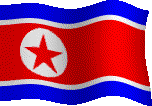



Day 3: In Panmunjom, They Say The Americans Started The Korean War!

Panmunjom (Huge building on
the far side is South Korean, the smaller buildings in front used to be the
Neutral Nations' meeting buildings, each one dissected by the Demarcation
line) - picture by Peter Deegan
We drove southeast towards the 4km-wide DMZ. Near its entrance, we got off to take pictures of the highway sign pointing south “Seoul 70km”. On this godforsaken ground of rice fields and occasional concrete anti-tank barriers, it was hard to believe that Seoul and its bright lights, glass towers, hedonistic discos, massive shopping malls and bustling streets are all but an hour and a half away. Isn’t it a twist of fate that these poor farmers could well have been ploughing the fields on modern semi-automatic tractors rather than the poor overworked ox they are using now?
We stopped briefly for our guides to complete the paperwork and also to wait for the DMZ military guides to arrive. “This is a high alert zone,” Ms Park said, “everyone has to be vigilant in case the enemies does anything. There would be a few soldiers coming with us to ensure our safety.”
One must not forget that the DPRK, with more than a million men under arms and reserve forces of 6 million, has the third largest armed forces in the world. According to Michael Breen’s “Kim Jong Il”, DPRK “spends only US$5.1 billion per year on defence, less than half South Korea’s defence budget, but this amount represents a staggering 31.3% of the country’s GDP. This small country of only 22 million is the most militarised nation in the world.”
Even then, Michael Breen commented that “the economy is so shattered that there is scarcely any fuel… the North has suffered so much food shortage… that is, if South Korea reinforced the DMZ with a line of food courts, offering free Big Macs for North Korean customers with rifles, it would all be over in minutes.” What do you think?
Whatever it is, quite ironically, security on the North Korean side appeared considerably less than in the South which I visited late last year. Over the South Korean side of the DMZ, one came across numerous American and South Korean troops and military installations, ranging from huge concrete anti-tank barriers to electric fences and endless military checkpoints. I was also required to sign forms acknowledging the dangers of the excursion and agreeing to various rules of conduct and waiving the rights to sue the authorities if accidents were to occur.
The most ridiculous thing in the South was, that no one was allowed to wear jeans in the DMZ, for they say that would justify (in what ways I still do not know) North Korean claims that the South is an American colony. On the other hand, no one cared what your wore in the North. Some in our group wore jeans and we didn’t have to sign any forms or told about any precautions.
Our DMZ guide was a good-looking and rather confident officer in his thirties. He gave an interesting introduction over a large relief and model map of the area and then we were driven into the DMZ, where we had a distant view of the ridiculously large North Korean flag (largest flag in the world) and the equally silly huge flag of the South on the other side of the demarcation line.
We headed for the Joint Security Area (JSA), a compound which used to be jointly maintained by forces from both sides. However, as a result of the infamous Axe Incident in 1976 during which an American army captain was axed to death by North Korean soldiers for chopping down a tree that affected the view of a US/UN checkpoint, the JSA was divided into two and no one was allowed to cross the demarcation line to the other side. The US/South Korean side had proclaimed the killed captain a martyr of freedom whereas the North had described the incident as further proof of US aggression. Who’s right and who’s wrong?
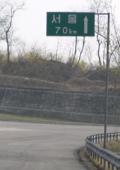
The sign says "Seoul 70km"
|
|
|
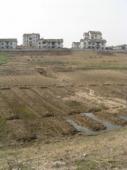
Just outside the DMZ
|
|
|
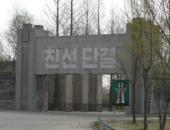
Fortress like entrance to the DMZ
|
|
|
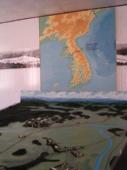
Model map of the DMZ/Panmunjom area
|
|
|
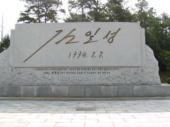
Carving of the Great Leader's signature
|
|
|
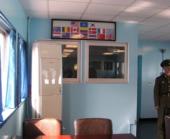
In the Panmunjom Neutral Nation's building
|
|
|
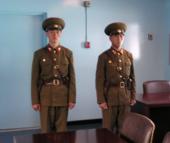
Hey man, want to club in downtown Seoul?
|
|
|
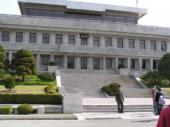
Watch building on the North Korean side of the JSA
|
|
|
From a huge building overlooking the compound, we watched the tall American and South Korean (which the North calls the “south Korean puppet regime”) soldiers. We visited one of the meeting buildings which straddled the demarcation line – what a thrill entering the same building we did last year from the other side!
It was also interesting that US and South Korean soldiers wore dark classes which made them looked dubious and forbidding, which was not helped by their rather stiff “ready-to-fight” taekwando posture they adopted in the DMZ grounds. In contrast, the North Koreans wore no dodgy dark glasses, and walked around in an easygoing manner. In fact, this was exactly what we had observed during our visit from the South last year, so it wasn’t a show put up by the North.
The Armistice Talks Hall one kilometre from the JSA was next, where our officer guide (who was quite guarded about revealing his rank or name) gave us a brief introduction to the DPRK version of the Korean War. “The American imperialists started the Korean War,” he said, “and DPRK, under the leadership of the Great Leader, defeated them upon a few kilometres of their incursion.”
Once again, one gets an alternative version of history so different from the ones we are familiar with. Of course, he did not explain how the North managed not only to defeat American incursions but also to capture Seoul within three days and 90% of South Korea within one month.
He did, however, raised a few valid points. Nuclear weaponry is the cheapest and most practicable way for DPRK to protect itself. DPRK’s actual nuclear capability forces the US to negotiate with North Korea instead of invading the country as it did to Iraq which was only trying to develop nuclear capability (and of course, the US invaded Iraq really for that dirty three letter word.). And he said, “Why is it that the US can have the largest nuclear arsenal in the world and yet does not allow anyone else to develop their own nuclear capabilities?”
It was with great pride that in 1998, the North Koreans launched a Taepodong missile over Japan into the Pacific Ocean. Not only did that showed the world North Korean missile capability (and the fact that it could soon reach the North American coast) but also demonstrated the helpless of Japan, a much larger country. Despite the animosity between the North and the South, the South Koreans viewed the incident with barely concealed delight, for they tended to dislike the Japanese more and hoped to inherit those missiles once reunification has taken place.
We also discussed Bush and Iraq, and this was where most of us agreed that none of us liked Bush, and that the world has become a very dangerous place given Bush’s policies. He also asked us, “Do you think DPRK is an axis of evil?” To that, we managed to divert the question to other issues. Whilst we have as a result of the trip developed great warmth for the North Korean people – for all their politeness, friendliness and hospitality – it was more difficult to approve the regime’s track record – the bombing of South Korean airliner, military incursions and assassinations or attempted assassinations of the South’s leaders. But one thing is certain. Many of us could not stand George W. Bush.
Here in this mini museum where armistice negotiations took place, one finds the axe (murder weapon to the South Koreans and Americans) used in the Axe Incident as well as whole lot of “evidence” proving that the Americans had started the Korean War – in fact, we bought a little booklet “The American Imperialists Started the Korean War,” and another, “America – The Empire of Terrorism”.
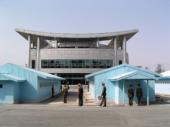
Building on the South Korean side
|
|
|
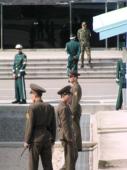
Soldiers of the North (brown) and South (green)
|
|
|
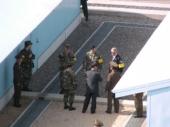
US soldiers speaking to North Korean soldiers along the line
|
|
|

The Man
|
|
|
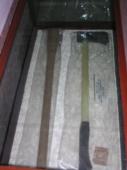
The infamous axe
|
|
|
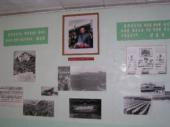
Exploits of the Dear Leader
|
|
|

The Great Leader at a military parade
|
|
|

The Great Leader at a military parade
|
|
|
Forget about Reuters, AFP or AP. The Korean Central News Agency (KCNA) (http://www.kcna.co.jp/index-e.htm) of North Korea is my favourite. Here’s one of their eternal pieces:
Marshal Kim Jong Il, how does the world name him-
The political, military, business, academic and publishing and press circles in more than 160 countries over the world attached the most honorific appellation to Marshal Kim Jong Il.
The titles summed up so far numbered more than 1,200. Some of them are as follows.
The great star of Korea, born by the great sun/ the sun of the revolution/ the sun of Juche/ the sun of mankind/ the sun of the 21st century/ the sun of hope/ the sun of life/ the eternal sun/ the unparalleled hero/ the greatest saint/ the paragon of loyalty/ the skillful and veteran statesman/ fascinating statesman/ the master of diplomacy/ the supreme incarnation of faith / the ever-victorious commander/ the symbol of invincibility and ever-victory/ the greatest general/ the perfect military strategist/ the marvelous strategist and tactician/ the heaven-sent hero/ the high intelligent and almighty leader/ the unrivaled great man/ the greatest personifier of human wisdom/ the master of philosophy/ the incarnation of might displaying infinite creative ability / the master of literature and art and architecture/ the genius of human music/ the world-level literary giant/ the great veteran of humanity/ the heaven of all the people/ the destiny of the world/ the helmsman of the world/ the top brain of the world revolution/ the heart of the world/ the great leader who will lead the 21st century / the guardian of our planet…
The world progressives boundlessly revere and follow Kim Jong Il as the great sun, legendary great man and outstanding leader of the 21st century. Human history has recorded many great persons. However, it has not witnessed such a great man as Marshal Kim Jong Il who is worshipped by all people of the world with different nationalities, social systems and political views.
Under the leadership of the Marshal humankind, is vigorously advancing toward a bright future of the 21st century. With the national pride of being led by the great Marshal who enjoys absolute respect and reverence of the world progressives, the Korean people will wage a more vigorous struggle for the independent reunification of the country.
Hurrah! I’m so proud to have stood on the sacred soil of the DPRK!
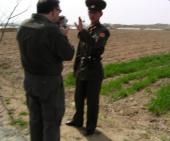
No photo, please!
|
|
|
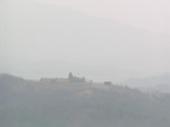
South Korean garrison
|
|
|
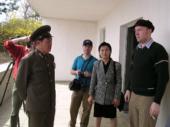
Watching the Concrete Wall
|
|
|
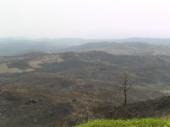
Where is the Concrete Wall?
|
|
|
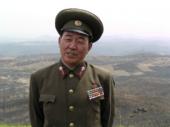
Our guide
|
|
|

Map showing US bases in South Korea
|
|
|

Reunify Korea!
|
|
|
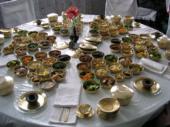
Our royal Koryo lunch!
|
|
|
After leaving the DMZ, we headed back to town and then picked up another military officer for a visit to the Concrete Wall. Located on another part of the DMZ accessible from Kaesong only via a bumpy, winding road, the Concrete Wall is, according to the North Koreans, the equivalent of the Berlin Wall on the Korean Peninsula, and it prevented all contact and links between the people of the North and South. Sure, as though there were no other barriers between the two states.
We strained our eyes looking for the wall via telescope but none of us were sure of what actually we were seeing, especially when it was rather misty and everything in the background – whether trees, bushes, ground or installations – all looked blurry from such a distance. The South Korean military post 4km away saw us and spoke (in Korean) using their loudspeakers – “We notice you tourists over that side!”
Back to Kaesong at the exuberant Unification Restaurant on the slopes of the hill on which the golden statue of Kim Il Sung stood, we had a wonderful lunch of royal Koryo dishes served in gold and silver coloured tableware. Crowds holding bouquets of flowers were walking solemnly uphill to pay their respects to the Great Leader. Royal food in a royal place at the foot of a royal hill!
We had a quick visit to Koryo Historical Museum, located in ancient university complex, where we learned how much slaves cost during the Koryo dynasty and where museum staff tried their best selling us the famous Kaesong Koryo ginseng.
We also stopped by the Sonjuk Bridge where an official and his servant were assassinated in 1392 for being loyal to the overthrown Koryo Dynasty. Blood of the murdered, the Koreans claimed, could still be seen on the bridge. Yes, a pinkish patch on the bridge indeed. Next to the bridge is a shrine dedicated to the murdered. This has become a pilgrimage spot devoted to loyalty as one of the supreme virtues of Confucianism. Here, an older ideology and value system was at work, and it was worth noting that the Kim’s are keeping this alive. Maybe Confucianism would be a more lasting and viable ideology than any other currently in force in the land.
|
|
|
|
|
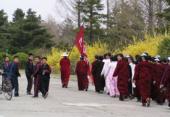
Pilgrimage to Kim Il Sung's monument, Kaesong
|
|
|
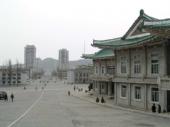
View of Kaesong just outside the Reunification Restaurant
|
|
|
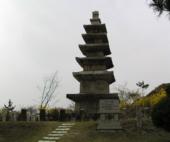
Koryo towers, Kaesong
|
|
|
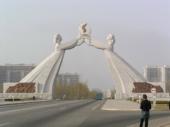
Reunification Monument just outside Pyongyang
|
|
|
International reports say that North Koreans are still suffering from the effects of the famine. According to the Asian Times, “UN nutrition surveys show that North Korean 7-year-olds today are fully 20 cm shorter and 10 kilograms lighter than their South Korean equivalents.” Indeed, before we reached the border city of Sinuiju, we have hardly seen any plumpish man in this country, apart from the two leaders whose photos we saw everywhere.
North Koreans also appeared shorter than South Koreans I have met last year. People in Pyongyang appeared rather “normal” though nobody seemed overweight, whilst some of the people who saw in the countryside did looked somewhat undernourished.
----
 Mt Paektu, Paetusan (“white-topped mountain”) in Korean, Changbaisan (“eternally-white mountain”) in Chinese. This is an extinct volcano with a crater lake (Lake Chon) on top, which lies on the Chinese-North Korean border. It is the tallest mountain of the Korean Peninsula at 2,750m above sea level.
Mt Paektu, Paetusan (“white-topped mountain”) in Korean, Changbaisan (“eternally-white mountain”) in Chinese. This is an extinct volcano with a crater lake (Lake Chon) on top, which lies on the Chinese-North Korean border. It is the tallest mountain of the Korean Peninsula at 2,750m above sea level.
According to Korean mythology, it was here that a god descended on Earth, married a woman transformed from a bear, and gave birth to Tangun, the first Korean king. Tangun, founded the city of Pyongyang and the first Korean kingdom of Chosun (Korea in the Korean language), and ruled for more than 1200 years (Wow – he must had been the oldest man on Earth!). Even today, South Koreans fly direct to Yanji on the Chinese side of the border, and travel to Mt Paektu to pay tributes to the gods and their ancestors.
DPRK official accounts say that Kim Il Sung set up base at Mt Paektu to fight the Japanese, and a star and two rainbows appeared over the mountain when Kim Jong Il was born at a secret camp here. Thus the “unbroken line of great rulers of Korea from Tangun to Kim Jong Il”.
----
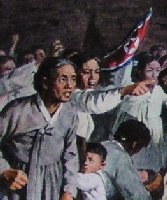 Driving back to Pyongyang, we passing the gigantic Reunification Monument which comprised of two ladies stretched across the highway. This highlighted the Korean desire for reunification and Kim Il Sung’s proposal for a Koryo Democratic Confederal Republic to be formed between the North and South. As we sped through town, many parts of Pyongyang were celebrating the birthday of Kim Il Sung, with public concerts and marches. The whole city was in a carnival mood, with colourful banners and billboards.
Driving back to Pyongyang, we passing the gigantic Reunification Monument which comprised of two ladies stretched across the highway. This highlighted the Korean desire for reunification and Kim Il Sung’s proposal for a Koryo Democratic Confederal Republic to be formed between the North and South. As we sped through town, many parts of Pyongyang were celebrating the birthday of Kim Il Sung, with public concerts and marches. The whole city was in a carnival mood, with colourful banners and billboards.
We dropped by the Foreign Languages Bookshop but the employees had shut down early to do the “Kim Il Sung pilgrimage”. We went to the Stamp Shop instead and there all of us went crazy buying North Korean stamps, most of which depicted themes relating to the country’s leaders. We also bought quite a few stamps showing anti-US motifs. At the bookshop at Koryo Hotel next door, we bought a book written by Kim Jong Il on filmmaking. Yet another masterpiece by this glorious leader.
Buying things in this country can be a big hassle. Anything on sale for foreigners are quoted in the Euro but change is often lacking. Instead, cashiers would give you assorted notes and coins in various currencies, principally Chinese RMB and US$. On one occasion, I got change back in Euro coins, RMB, yen coins and a chewing gum!
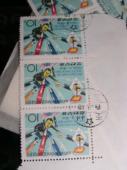
Crush USA stamps
|
|
|
|
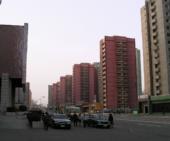
"Restaurant Street", Pyongyang
|
|
|
|
Day
4: Kim Il Sung Won The Korean War
Buy these books!
|
Copyright - Tan Wee Cheng, Singapore, 2004
|







 Mt Paektu, Paetusan (“white-topped mountain”) in Korean, Changbaisan (“eternally-white mountain”) in Chinese. This is an extinct volcano with a crater lake (Lake Chon) on top, which lies on the Chinese-North Korean border. It is the tallest mountain of the Korean Peninsula at 2,750m above sea level.
Mt Paektu, Paetusan (“white-topped mountain”) in Korean, Changbaisan (“eternally-white mountain”) in Chinese. This is an extinct volcano with a crater lake (Lake Chon) on top, which lies on the Chinese-North Korean border. It is the tallest mountain of the Korean Peninsula at 2,750m above sea level.  Driving back to Pyongyang, we passing the gigantic Reunification Monument which comprised of two ladies stretched across the highway. This highlighted the Korean desire for reunification and Kim Il Sung’s proposal for a Koryo Democratic Confederal Republic to be formed between the North and South. As we sped through town, many parts of Pyongyang were celebrating the birthday of Kim Il Sung, with public concerts and marches. The whole city was in a carnival mood, with colourful banners and billboards.
Driving back to Pyongyang, we passing the gigantic Reunification Monument which comprised of two ladies stretched across the highway. This highlighted the Korean desire for reunification and Kim Il Sung’s proposal for a Koryo Democratic Confederal Republic to be formed between the North and South. As we sped through town, many parts of Pyongyang were celebrating the birthday of Kim Il Sung, with public concerts and marches. The whole city was in a carnival mood, with colourful banners and billboards.